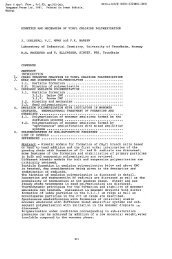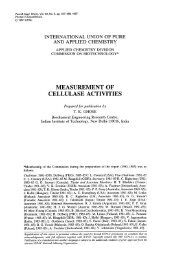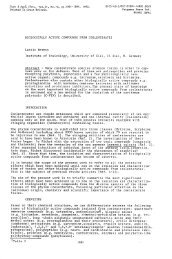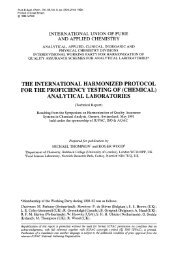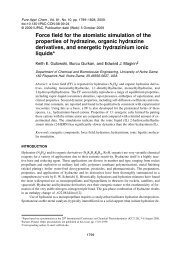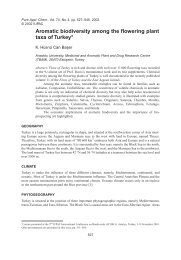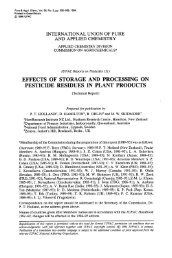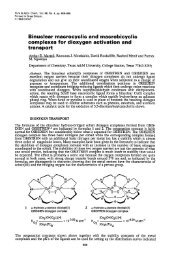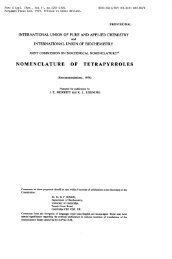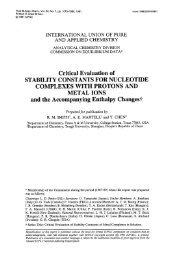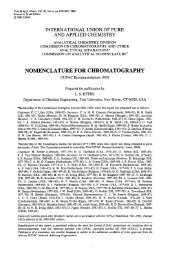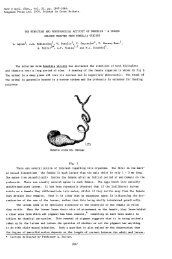Protolytic equilibrium in lyophilic nanosized dispersions ... - IUPAC
Protolytic equilibrium in lyophilic nanosized dispersions ... - IUPAC
Protolytic equilibrium in lyophilic nanosized dispersions ... - IUPAC
You also want an ePaper? Increase the reach of your titles
YUMPU automatically turns print PDFs into web optimized ePapers that Google loves.
1474<br />
N. O. MCHEDLOV-PETROSSYAN<br />
Allied <strong>in</strong>dicator systems, with a fluoresc<strong>in</strong>g dye (e.g., fluoresce<strong>in</strong>) conjugated to a biomolecule,<br />
are often used <strong>in</strong> biochemical studies and related fields [23c,d,69]. The pK ac<br />
a alterations are usually ascribed<br />
to conformational or some other changes, or local electrical potentials. However, <strong>in</strong> case the<br />
whole difference between the pK ac<br />
a and pKw a values is attributed to the (–ΨF/RT ln10) term, the contribution<br />
of the log( wγ m B / wγ m HB ) item is underestimated.<br />
It is appropriate to mention here another k<strong>in</strong>dred branch of papers devoted to optical pH-respond<strong>in</strong>g<br />
sensors. Such dye-based devices are widely used for different purposes, from physiological<br />
research to monitor<strong>in</strong>g of seawater [24]. As a rule, the colored and/or fluoresc<strong>in</strong>g <strong>in</strong>dicator is covalently<br />
or noncovalently embedded <strong>in</strong> a polymeric or sol-gel matrix. The quantitative description is similar to<br />
the above equations, but <strong>in</strong> some cases an attempt is made to take <strong>in</strong>to account the activity of water <strong>in</strong><br />
the media surround<strong>in</strong>g the <strong>in</strong>dicator. However, <strong>in</strong> expressions analogous to eq. 12, the term log w γ m H +<br />
was not taken <strong>in</strong>to account; this also refers to some other publications [17f,h].<br />
F<strong>in</strong>ally, water-<strong>in</strong>soluble long-tailed <strong>in</strong>dicators have been developed, which can be used for determ<strong>in</strong>ation<br />
of pH <strong>in</strong> an <strong>in</strong>accessable aqueous phase, which is of significance for understand<strong>in</strong>g biocatalysis<br />
<strong>in</strong> organic media [70]. Such systems are closer to common two-phase (extraction) systems and reversed<br />
(water-<strong>in</strong>-oil) microemulsions, which are beyond the shape of the present paper.<br />
Now let us consider other models used for quantitative description of acid–base equilibria <strong>in</strong> micellar<br />
solutions of colloidal surfactants.<br />
OTHER APPROACHES FOR DESCRIPTION OF MICELLAR EFFECTS<br />
Though the surface of micelles formed by ionic surfactants is charged, the micellar effects can be described<br />
without us<strong>in</strong>g the Ψ values [26,28b,32a,71]. Some authors used only the <strong>equilibrium</strong> constants<br />
of partition between the aqueous and micellar phases, or of b<strong>in</strong>d<strong>in</strong>g of the <strong>in</strong>dicators or other reactants<br />
by the micelles, or of reactants’ association with surfactants [32a,52a,72]. In general case, such b<strong>in</strong>d<strong>in</strong>g<br />
(association) constants can be recalculated to the Pi constants (eq. 10) and thus (<strong>in</strong> the case of ionic<br />
surfactants) implicitly <strong>in</strong>clude the Ψ values. Similar approaches can be used for process<strong>in</strong>g the micellar<br />
liquid chromatography data [3a,b,e–h].<br />
The constants of HBz and Bz–1 b<strong>in</strong>d<strong>in</strong>g by micelles (or droplets of microemulsions) can be obta<strong>in</strong>ed<br />
us<strong>in</strong>g the dependences of pK a<br />
a on surfactant concentrations (or volume fraction of dispersed<br />
phase) [72a,b,73]; the correspond<strong>in</strong>g equations will be considered somewhat later. However, this is impossible<br />
<strong>in</strong> the case of very hydrophobic, water-<strong>in</strong>soluble <strong>in</strong>dicators, which are practically completely<br />
bound by micelles.<br />
Alternatively, Berez<strong>in</strong>, Bunton, Romsted, and some other authors developed another model for<br />
equilibria <strong>in</strong> solutions of ionic surfactants. This model is based on the concept of pseudophase ion exchange,<br />
or PIE [1b,27e–h,34a,74]. Namely, it is supposed that the <strong>in</strong>crease <strong>in</strong> pHw leads to the decrease<br />
<strong>in</strong> H + m concentration and to the <strong>in</strong>crease <strong>in</strong> that of OH – m <strong>in</strong> the Stern layer, as a sequent of ion exchange.<br />
In the case of pHw decrease, the result is opposite. The aforementioned β parameter of ionic micelles<br />
(β = 1 – α) is assumed to be constant; more detailed consideration and perfection of the PIE model is<br />
available <strong>in</strong> literature [1c,d,f,61a,75].<br />
The pr<strong>in</strong>cipal equations of PIE model are based on a special concentration scale<br />
[1b,c,k,27e–h,75]. Turn<strong>in</strong>g to the molar concentration scale, the relations between the pK ac<br />
a and pK a m<br />
values can be rewritten for micelles of cationic [28a] and anionic surfactants, respectively, <strong>in</strong> the follow<strong>in</strong>g<br />
manner:<br />
pKac a = pK a m + log{(K X–<br />
OH – KW m ) (βsK w<br />
W) –1 } + log[X –<br />
w ] (18)<br />
pKac a = pK a m + log(βs/K M+<br />
H + ) – log[M+ w ] (19)<br />
Here, KX– OH – is a constant of OH– ion exchange for X – ions (X – = Cl – , Br – , NO –<br />
3 , etc.) <strong>in</strong> the Stern layer<br />
of cationic surfactant micelle, KM+ H + is the constant of H+ (hydronium) ion exchange for M + ions<br />
© 2008 <strong>IUPAC</strong>, Pure and Applied Chemistry 80, 1459–1510



